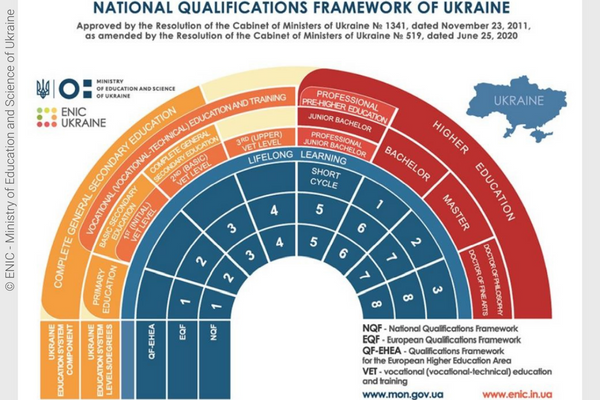Recognition of qualifications of Ukrainian school pupils

The Ukrainian education system
To understand Ukrainian qualifications, the Ukrainian National Information Centre for Academic Mobility provides detailed information on the Ukrainian education system. It is part of the ENIC-NARIC Network, a joint initiative of the European Commission, the Council of Europe and UNESCO, which helps organisations and individuals to easily find information on procedures for the recognition of foreign qualifications. It also lists recognition tools and projects, such as the Ukrainian Qualifications database, which fosters knowledge of different Ukrainian higher education qualifications.
Further structured information on all levels of education, including a link to curricula, is provided by the European Training Foundation. School Education Gateway has published an article summarising the recent education reform in Ukraine.
School leaving certificate and access to higher education
Rules on recognition of higher education qualifications for both professional purposes and further learning are set by the Lisbon Recognition Convention, which was ratified by the EU Member States (except Greece) and Ukraine. The Convention’s basic principle is that qualifications must be recognised, unless the institution dealing with the recognition proves that there are substantial differences between the foreign qualification to be recognised and its domestic correspondence.
The NARIC network developed the Erasmus+ Q-entry project, a database that provides information on school leaving qualifications giving access to higher education in their national context in EU and non-EU countries. This database, which includes information on Ukrainian qualifications, can be used to support recognition process for persons granted temporary protection.
Furthermore, the Ukrainian Ministry of Education and Science provided a
of admission requirements and qualification levels in Vocational Education and Training (VET).
Coping with missing documentation
One challenge that can arise from assessing a refugee’s qualifications is missing documentation. In its recommendation of 5 April 2022 on the recognition of qualifications for people fleeing Russia’s invasion of Ukraine, the European Commission encourages Member States to first check whether reliable confirmation of the qualification can be obtained from the Ukrainian authorities. The Lisbon Recognition Convention (Article 7) foresees additional efforts in this context. There are several tools available, including:
- the Erasmus+ Refugees and Recognition – Toolkit 2 (REACT) project has developed specific tools and methodologies for credential evaluators that can lead to possible pathways for these circumstances;
- the European Area of Recognition Manual (funded by Erasmus+) contains standards and guidelines on all aspects of the recognition of foreign qualifications and on the recognition of qualifications of refugees;
- the Council of Europe’s European Qualifications Passport for Refugees is a specially developed assessment scheme for those who do not have access to all their documentation and qualifications, issuing them a standardised document that explains the qualifications a refugee is likely to have based on the available evidence;
- the UNESCO qualifications passport for refugees and vulnerable migrants aims to increase access for refugees and vulnerable migrants to higher education through the recognition of prior learning and qualifications. It is a standardised statement, which contains three parts – the assessment part, the explanatory part and the third part, concerning next steps.

